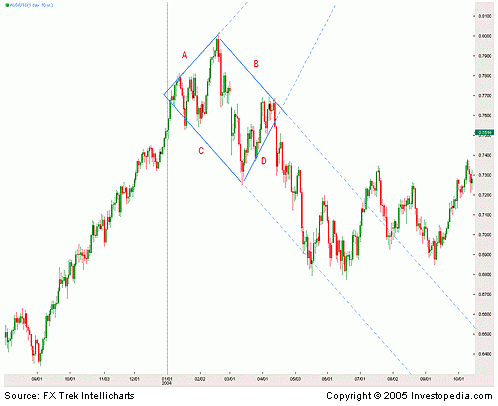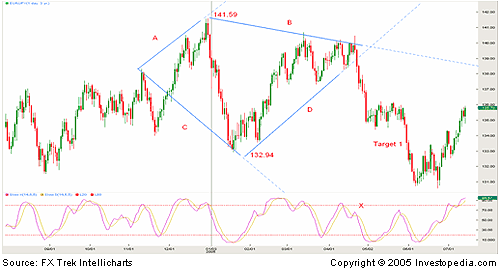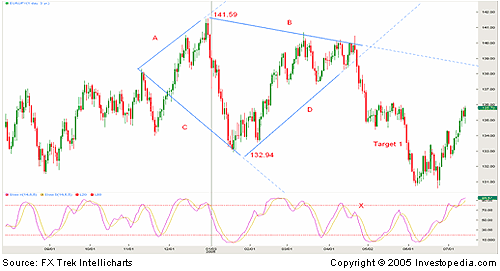For years, market fans and binary traders alike have used simple price models to not only anticipate lucrative trading opportunities, but also to explain simple market dynamics. As a result, common formations such as pennants, flags and double bottoms/tops are often used in the foreign exchange markets, as well as many other trading markets. Little has been said about it, but an equally successful pattern that is found in currency markets is the bearish higher diamond formation. Commonly known as the “diamond top”. In this article, we will explain how currency traders can quickly identify diamond peaks in order to earn money by applying various opportunities.
The “diamond top” occurs mostly at the top of uptrends. This actually signals imminent deficits and recoveries with relative accuracy and ease. Because of the increased liquidity in the foreign exchange market, this formation may be more easily defined in the foreign exchange market than in its basic shareholder copy, where gaps in price action often occur, crowding out some of the requirements needed to identify a diamond top. This formation can also be applied to any period of time, especially in daily and hourly charts. Since the wide fluctuations often seen in the foreign exchange markets will offer traders a variety of trading opportunities.
Identification & Trading Formation
The diamond summit formation is established by the first insulation shifted from the center of the head and shoulder formation, and the application of trend lines depends on subsequent peaks and troughs. It got its name due to the fact that the model has a striking resemblance to a tetrahedral diamond.
Let’s look at a step-by-step analysis of how to trade the formation using the Australian dollar/US dollar (AUD/USD) currency pair (Fig. 1) as an example. First, we determine the head and shoulders offset from the center of the formation in the currency pair. Next, we draw the resistance of the trend line, first from the left shoulder to the head (line A) and then from the head to the right shoulder (line B). This forms the upper part of the formation; As a result, price action should not break above the upper resistance of the trend line formed by the right leverage. The idea is that the price consolidates before the looming shortage, and any penetrations above the trend line ultimately render the picture ineffective, as this would mean that a new peak has been created. As a result, the trader will also be forced to consider the repeated trend line (line B), which goes from the head to the right shoulder, or not pay attention to the “diamond top” formation at all, since the picture was disturbed.
To establish the lowest support of the trend line, the specialist will simply look at the lowest trough set in the formation. The support of the lower side can then be made by connecting the lower end to the left shoulder (line C) and then connecting another trend support line from the end to the right arm (line D). This connects the bottom half to the top and completes the model. Notice how the rightmost corner of the formation also resembles the vertex of a symmetrical triangle pattern and resembles a breakdown.

Trading the diamond summit is not much more complicated than trading other formations. Here, the trader is simply looking for a break from the lower support line, assuming a build-up momentum for a possible deficit. The theory is quite simple. Both the resistance of the upper and lower support levels set in the right arm will contain price action as the range decreases in each subsequent session. Which also suggests a short-term breakout. As soon as the session closes below the support level, it means that the momentum selling will continue because sellers have finally advanced almost below this significant mark. The trader will then want to place his/her record below this level in order to capture the subsequent price decline. This approach works particularly well in foreign exchange markets, where price action tends to be more flexible and where trends are set faster once a certain substantial support or resistance is broken. Monetary management can be applied to this position through a stop loss placed slightly above the previously broken support level; to minimize any losses that may occur if the breakout turns out to be false and a temporary pullback occurs.
Figure 2 below shows the enlarged image in Figure 1. We can see that the session candle has closed below or “broken” the main trend line (D.i. line), which indicates a downward movement. The best diamond traders can profit from this by placing an entry order below the close of the support line at 0.7504 (while placing the stop loss also slightly above the same line) to minimize any potential losses if the price returns back above. The standard stop will be placed 50 pips higher at 0.7554. In our example, it will be impossible to stop the order because the price did not jump back, instead of falling 150 pips lower in one session before falling even lower in the future.

Finally, profit targets are calculated by taking the width of the formation from the head of the formation (maximum price) at the bottom of the end (low price). Staying with our example using the AUD/USD currency pair, Figure 3 shows how this will be done. In Figure 3, the AUD/USD exchange rate at the top of the formation is 0.8003. The bottoms of the “diamond top” give an exact 0.7250. This leaves 753 pips between the two prices, which we use to form the maximum price where we can take profits. To be on the safe side, the trader will set two targets in which to take profits. The first goal would require taking in full, 753 pips, as well as taking half of that amount and subtracting it from our entry price. Then, the first target will be 0.7128. The target price that maximizes our profits would be 0.6751, calculated by subtracting the full 753 pips from the entry price.
Using Price Oscillator Hints
One of the cardinal rules of successful trading is to always receive confirmation, and not to apply any other model than the “diamond top”. Adding price oscillator hints such as: moving the divergence of the average convergence and the relative strength index can improve the accuracy of your trading. Tools like these can measure the inertia of price action and be used to confirm a breakout of support or resistance. By applying the stochastic oscillator, following our example (Figure 4 below), the investor confirms a break below the support through the descending cross that occurs in the price oscillator (specify X).

Putting it all together
Bearish diamond peaks are formed not only in major currency pairs like the Euro/US Dollar (EUR/USD), the British Pound/US Dollar (GBP/USD), the US Dollar/Japanese Yen (USD/JPY); but also in lesser-known cross-currency pairs such as the euro/Japanese yen (EUR/JPY). Although formation occurs less frequently in cross-currency pairs, however, such pairs can sometimes create more profits. Let’s take a look at a step-by-step example of this using EUR/JPY:
1. Identify the head and shoulder pattern and confirm the offset nature of the formation by noticing that the head is slightly to the left while the end is set to the right.
2. Form a higher resistance by connecting the shoulder of the left side to the top of the head tip (line A) and the head to the right shoulder (line B). Then draw trend lines for support by connecting the shoulder of the left side (line C) with the end to the end of the right shoulder (line D).
3. Calculate the width of the formation by taking the prices at the top of the head, 141.59, and the bottom of the end, 132.94. This will give us a total of 865 points of distance before we can take our full profit. Divide by two, and our first point will lock in a profit of 432 pips, which is below our entry.
4. Set the entry point. Look at the top of your right shoulder and notice the point where the candlestick closes below the support line, acting ahead. Here, the closing of the session is 137.79. The entry order should be placed 50 pips lower at 137.29, while our stop loss will be placed 50 pips higher at 137.79.
5. Calculate the first profit price by subtracting 432 pips from the entry. As a result, the first profit target will be at 133.45.
6. Finally, confirm the trade with the price oscillator. Here, the stochastic oscillator signals forward and confirms the possibility of a break below the overbought level (point X).
If the first target is reached, the trader will move his/her stop to the first target and then place a trailing stop to protect any further gains.
Dry residue
Although the bearish diamond top has received enough attention due to its rarity, it remains very effective in displaying potential opportunities in the forex market. The price action of the smoothing circuit, due to the huge liquidity of the market, offers traders the best conditions to apply this method and highlight the best opportunities. When this formation is combined with the price oscillator, trading becomes even better. The Price Oscillator increases the overall probability of a profitable trade by measuring momentum and weeding out false breakouts or breakouts of trades.
Tagged with: proximate analysis


